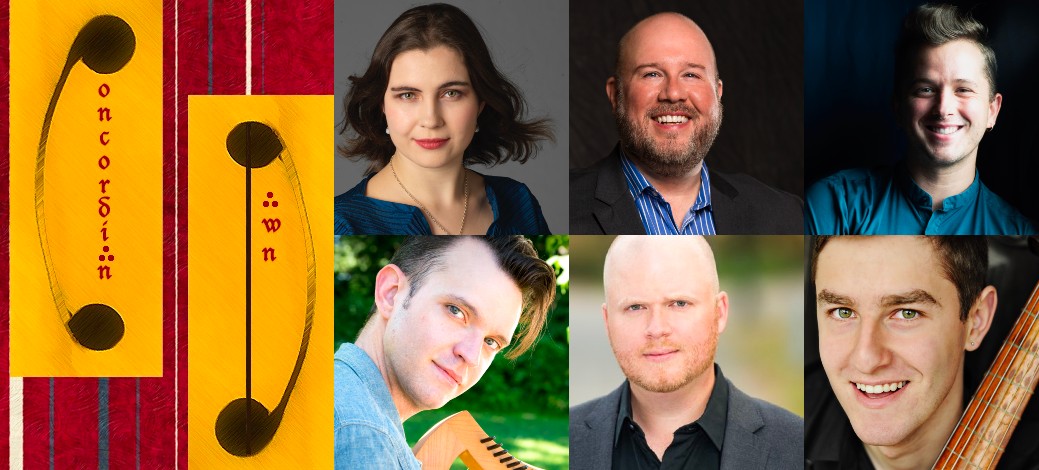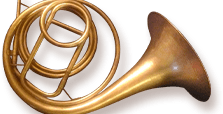May 2023
An interview with director Christopher Preston Thompson
Christopher, thank you so much for joining us! We are thrilled that Concordian Dawn is part of the GEMS family and want you to know how much we treasure your ensemble.
Can you tell us what drew you to the study and performance of Medieval music?
First, I would like to thank you very much for your kind words and for inviting me to do this interview. GEMS continues to give such great support to Concordian Dawn, and we value our relationship with you very much. Regarding what drew me to Medieval music, it was mostly a fascination with the evocative sound world and a curiosity to get to know it more intimately. After I moved to New York City and started getting hired to do early music gigs, I encountered Medieval music performances in real time for the first time — not just on recordings or in the classroom, as before, but live and in-person. It was very intriguing and exciting. At one point, I saw a colleague accompany herself on Medieval harp while singing a troubadour song, and I was totally gripped by it. I thought it was one of the most beautiful things I’d ever witnessed, and I had to try it myself. That experience, in particular, opened the flood gate, and after I got my footing with the harp I founded Concordian Dawn as an outlet for more Medieval music experimentation and discovery. I’m very happy to be joined by some amazing colleagues in the ensemble: Amber Evans, David Dickey, Clifton Massey, Thomas McCargar, and Niccolo Seligmann. They are absolutely fabulous musicians, and it’s an honor to explore this amazing repertoire with them. On our recent projects released over the last year and half, we’ve also had Michele Kennedy, Karin Weston, and Andrew Padgett on board, and though they are not performing with the ensemble this season, I’m equally honored to have them remain an important part of our group’s trajectory.

When listening to Medieval music, 21st-century listeners can sense the music speaking to them, even at a remove of several centuries. Can you speak to this?
I often think of Medieval repertoire as material that can help us form a deeper understanding of our modern lives. At the core, we haven’t changed all that much since the Middle Ages. Details surrounding us have changed; technology has expanded in some ways; the world is probably louder and certainly filled with more electronic gadgets now than it was then. But, we still want, feel, and deal with the same things. Politics, war, plague, social struggle, religious fervor juxtaposed with skepticism or outright anger towards religion and/or hypocritical religious institutions, love, sex, heartbreak — all of these very modern issues that are inherent in our 21st-century lives are central to Medieval repertoire. When placed within a musical context that can be, at times, breathtakingly beautiful, and at other times strikingly modern-seeming in its peculiarity and its treatment of dissonance and consonance — and everything in between — there’s a lot to connect with for a 21st-century audience.
You mentioned the curiosity that led you to form Concordian Dawn? What else shapes the group and how do you select the repertoire you perform?
One of our foremost priorities as an ensemble is to explore primary source material and how the socio-philosophical mindset of those from centuries ago can connect with a modern audience. Our programs are most often shaped around text-driven themes, and we hope the programs help deepen our understanding of our own position within the universe. And, of course, sometimes our programming is commission driven, as in the quartet concert we performed at the Santa Cruz Baroque Festival in March.
Speaking of that performance in Santa Cruz, the GEMS audience was fortunate to hear Concordian Dawn preview the program, entitled “Order in Fours,” on our Midtown Concerts series. Can you tell us about your choice of music for those performances?
Indeed. The commission from SCBF was for a concert on their 50th Anniversary season, themed Powers of Four—essentially a season of quartet concerts. So, we developed a concert that plays with the idea of “fours” in various configurations: polyphonic songs composed for four voices and performed by four or more musicians; monophonic songs and instrumental dances arranged for four performers; a polyphonic song for three voices performed by four musicians; and a monophonic song arranged for no more than four performers at one time. When SCBF invited us to perform such a concert of Medieval quartets, specifically requesting organum quadruplum by Notre-Dame school composer, Pérotin, two other late Medieval French composers immediately sprang to mind as a perfect complement to the organum — Guillaume de Machaut and Philippe de Vitry. Both composers are a mainstay of our repertoire, and this commission gave us a great opportunity to add Machaut’s Messe de Nostre Dame to our repertoire, which had been something we wanted to do for some time. Of course, no Concordian Dawn concert would be complete without, at least, a couple of beloved trouvère songs. And, for balance, we peppered in a couple of earlier Medieval reconstructions and a few of our favorite Medieval instrumental dances.
Thinking beyond musical texture and performance forces, however, “Order in Fours” is grounded in symbolism surrounding the number four, which is considered by scholars to be the number of material order. In the Middle Ages, the number represented stability, a firm foundation, and order in the universe. Today, we find such order in a variety of ways. Some find it through learning, philosophy, and well-crafted art (“Tunc me discussa” and In virtute / Decens / Clamor); some through Hope as the remedy to Fortune (“Dame, de qui toute ma joie vient” from Le Remede de Fortune); some through the passage of time, the phases of the sun and moon, natural order, and the completion of justice (“Phebi claro” and Tribum / Quoniam / Merito). Others find it through salvific grace, mercy, and a belief in the firm foundation of religion, all reflected in the four points of the cross or other religious iconography (“Viderunt omnes” and La Messe de Nostre Dame). And, for some, such order is grounded in a transformative fin’amor, or true/refined love for another (“Fine amour en Esperance” and “Quant voi la flour boutener”). All of the repertoire on the program explores such symbolism through music of the 11th through 14th centuries that exhibits a proliferation of intervallic order: consonance in perfect musical fourths and Pythagorean perfections.
Your recent West Coast tour included a performance lecture at the San Francisco Conservatory of Music? How did you structure that session?
We centered the presentation around performance practice issues, such as notation and rhythmic interpretation, accompaniment and improvisation, text-inspired reconstructions and interpretations, intertextuality and polytextual musical interplay. We looked at manuscript images from various primary sources and discussed the issues at hand, and then the ensemble performed musical examples. The students were very interactive and asked great questions, so we had fantastic discussions about all the material.
Can you tell us about your collaboration with scholar Sarah Kay and the publication of Medieval Song from Aristotle to Opera (Cornell University Press and MSR Classics, 2022)? The title is fascinating. Does it imply the consideration of timeless issues regarding the human condition?
Absolutely. Collaborating with Sarah Kay on Medieval Song from Aristotle to Opera was a huge pleasure and honor. Her work is fresh and innovative, and this project is no exception. As such, it’s quite complex to try to summarize in a few sentences. Suffice it to say the book and its accompanying website explore ecologies of song in order to reimagine distinctive ways of sounding words. Medieval French and Occitan song comprise the bulk of repertoire analyzed alongside earlier poetry, later operatic works, and Aristotelian philosophy. Kay’s anachronic approach argues for a perspective on the manuscript song transmissions as instances of multi-media, quasi-operatic performances. The book is in dialogue with a companion website, which houses over three hours of recorded material by Concordian Dawn, editions of manuscript transcriptions and reconstructions that I made for the project, Sarah’s translations of original song texts, and performance-reflection essays I wrote to place the recordings in dialogue with her book.
It’s a multi-media, interdisciplinary resource that I am quite proud of, and the companion website is freely accessible. Explore website here
The book is available in hard copy or as an e-book here.
What’s next for Concordian Dawn? Are your future projects related to your own scholarly interests?
They are! It seems that my own scholarly interests are unavoidable when developing future projects for the ensemble. We’ll be releasing highlights of Medieval Song from Aristotle to Opera as an album this summer through MSR Classics, and we’ve got several concerts lined up featuring material from our debut album, Fortuna Antiqua et Ultra (available here). Plans are developing to record an album of Medieval carols, inspired by our annual Medieval lessons and carols program at St. John’s in the Village, NYC, and we hope to release that album in 2024 in time for the holidays. We recently recorded some new, medieval-inspired compositions by David Yardley, which will be released on his forthcoming album, and we have some more collaborations in the works, which we’ll be able to announce in the coming months. We have a residency at UC-Davis in February of 2024, and we’ll be performing in Pennsylvania, Princeton, and New York City this Fall.
For more information or to sign up for our mailing list, please visit www.concordiandawn.com, and feel free to reach out to us via our website anytime.
Listen to Concordian Dawn's debut album here:



